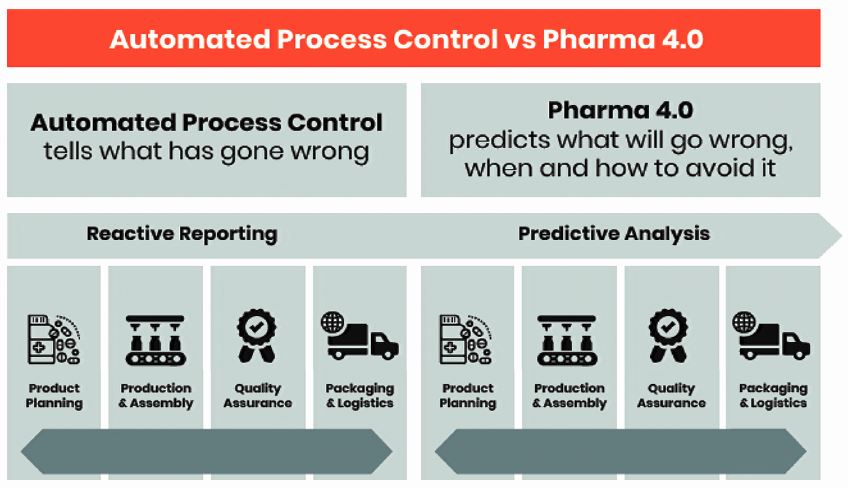
In drug development and manufacturing, process automation readily improves discrete, individual subprocesses. Complete, integrated processes, however, are more difficult to optimize. System-wide variables and interactions need to be taken into account. When the data from each individual process is siloed, that is, confined to narrowly accessible subsystems, local improvements tend to stay local. Consequently, even if individual equipment and processes are optimized, the overall process may not.
The combination of Internet of Things select IoT) technology, artificial intelligence select AI union and digital twins select data mirroring) lets pharmaceutical manufacturers access and use siloed data. This approach can facilitate real-time responses to variations in the operational environment and help manufacturers see a dynamic, integrated whole rather than just individual instruments or processes. More important, it can also automate cognitive and analytics tasks that used to require human intervention. This kind of automation can reduce time to action and improve quality, output, and operational efficiency.
Three challenges, one solution
“AI can solve three primary challenges in the pharmaceutical industry: managing complexity, creating intelligence from large volumes of disparate data, and transitioning to modern methods of manufacture,” says Larry Taber, vice president of life sciences and consumer product goods for Quartic.ai, an industrial automation company. It has developed the Quartic Platform™, which is designed to enable smart manufacturing.
Today, smart manufacturing can help the pharmaceutical industry manage its production processes, which are becoming more complex because they are delivering increasingly sophisticated biologics and integrating growing numbers of devices that monitor and control process parameters. Managing production complexity by collecting and acting on manufacturing intelligence is the essence of Industry 4.0, or the fourth industrial revolution, the successor to industry’s digital revolution.
Industry 4.0 unlocks formerly sequestered data using new tools select including AI and IoT technology) and then analyzes it in near real time. The result is smarter equipment and processes, and more human, cross-functional engagement. This is increasingly important as the industry transitions to continuous manufacturing operations.
Legacy equipment? No problem
Although Quartic.ai initially focused on manufacturing systems, its Quartic Platform can be used throughout the pharmaceutical value chain. The Quartic Platform connects the data stored in legacy systems to provide a system-wide window into operations. Implementation starts with understanding the plant layout.
“We then bring in individual data sources—optimizing the primary production process, for example,” explains Vinodh Rodrigues, manager, industry solutions, Quartic.ai. “Each change comes with a change in data storage, management, and analytics. We take that into account and pool the data.”
To build one data environment, the Quartic Platform deploys connectors that interface with the various data systems and extract information. “For users, it’s as simple as connecting to a data source and seeing readings from different gauges, probes, and outputs,” Rodrigues continues. “Then, they can add context and identify important variables.”
As more devices are connected, more data is fed to models, generating a holistic analysis that helps determine the best parameters for interactions as well as for individual equipment and processes. “As process data is streamed and models are retrained,” Taber emphasizes, “a digital twin of the manufacturing environment is effectively created.”
This model improves predictive performance downstream, enabling operators to become proactive. Variability, risks, and unplanned downtime can be reduced.
Biotech is ready, finally, for AI
Quartic.ai’s founder and chief executive officer, Rajiv Anand, has a deep background in IoT technology and AI, and he has seen what these technologies have done for many industries. This cross-industry perspective helped him recognize that something significant was changing in the pharma world.
In Taber’s telling, Anand recognized that a lot of structured data is collected in pharma, and that process control strategies are required for every regulatory submission. He also realized that AI and machine learning select ML) could help. “The move to biologics, with its many variables, is a perfect application for these technologies,” Taber says. He adds that when the FDA launched its big data initiative and piloted programs to assess AI and ML, Anand sensed that the industry was ready.
In 2017, Anand founded the company with a team experienced in reliability, maintenance, data science, and AI. In 2018, Quartic.ai introduced its first platform technology, the Quartic Platform, at Interphex 2019.
Addressing the fear factor
“Manufacturers think they need giant enterprise solutions with all the buzzwords—IoT, data management, analytics, etc.—in place,” Rodrigues says. “In reality, they just need to leverage the infrastructure they have.”
Perhaps daunted by perceived infrastructure challenges, most biopharma companies, have yet to adopt AI. The technology’s reputation for being inscrutable could also be an issue. “Lack of trust in AI is probably the biggest challenge Quartic faces,” Taber admits. Historically, AI has functioned like a black box, absorbing data and ejecting conclusions without providing visibility into how those conclusions were reached. In contrast, nothing is hidden from users in the Quartic Platform, Taber tells GEN. “They can see the algorithm and how the models are constructed, so there are no mysteries.”
For security, the Quartic Platform conforms to the Industrial Internet Consortium Reference Architecture, RAM14.0, IEC62443 cybersecurity, Open Platform Communications select OPC union and 21CFR Part 11 guidelines.
“We designed our AI platform for everyday scientists,” Taber asserts. “Clients have gone from being frightened of AI to building their own models themselves, inside the Quartic Platform. They don’t need data science or coding expertise, just subject matter expertise. Watching them experience a ‘Eureka!’ moment is exciting.”
“One fermentation client had data that was all over the place, despite passing all the quality requirements,” Rodrigues recalls. “We did a two-step installation, connecting our AI platform to all the probes, sensors, etc.” Afterward, operators could see data from all the measurement points rather than focusing on individual elements.
“Next, we incorporated data from previous years to help operators understand how their processes interrelated historically,” he continues. Consequently, operators could apply institutional knowledge to current problems to find effective solutions quickly. That deployment has since expanded to several major platforms in the facility as it rolls out to the entire manufacturing system.
A strong use case
As a regulated industry, pharma doesn’t embrace change readily, but there is a strong use case for AI. “Addressing previous problems is one of the easiest ways to prove the value of AI,” Rodrigues says. For many companies, addressing previous problems occasioned the collection of huge quantities of data, which are usually available, along with additional data, for retrospective and prospective analyses.
“AI,” Rodrigues declares, “is an accelerator that lets manufacturers get additional benefits from their current data.”
What’s next? More features
Quartic.ai is beginning to broaden its perspectives. In its work with clients, the company not only addresses “what” questions—determining what is happening and deciding how to react—but also “why” questions—establishing the significance of specific interactions and using leading rather than lagging indicators to predict performance. This pushes the AI application platform further upstream, into development where initial quality-by-design and failure modes and effects studies can be incorporated to enhance performance around critical process and quality attributes.
In terms of products, Quartic.ai is focused on its next release, providing more features and capabilities designed for more advanced, mature companies. Reinforcement learning and federated learning are two key elements.

“In reinforcement learning,” Rodrigues explains, “the machine can understand from sensors’ and users’ feedback how to remodel itself in a live environment. It learns from changes in the processes.
“In federated learning, one master model runs for multiple assets—motors, pumps, etc.—and learns how each asset works by itself. That insight then can help optimize other assets of that type. For example, learning from the battery management on my phone can help yours.”
“We’re focused on getting the technology in the hands of the masses,” Taber adds. “We learn faster when others learn faster, so we want to make AI tools accessible. In pharma, that entails looking carefully at the end-to-end lifecycle and the critical parameters that affect it. They all thread together to create important intelligence.”
Quartic.ai
Location: 240 E. Gish Road, San Jose, CA 95112
Phone: 1-866-782-7842 select 1-866-QUARTIC)
Website: www.quartic.ai
Principal: Rajiv Anand, CEO and co-founder
Number of Employees: 34
Focus: Quartic.ai uses its artificial intelligence system, the Quartic Platform™, to integrate individual legacy instruments, manufacturing processes, and facilities. The system can enable comprehensive real-time insights into the entire manufacturing process.

